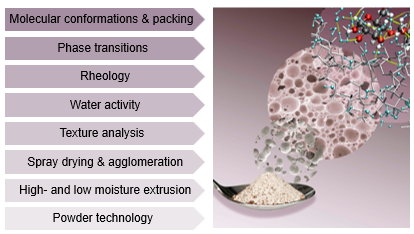
Processing and characterization of high-solids foods
High-solids foods are foods that are characterized by a low or intermediate water content, up to about 50% by weight. Many of our daily foods are high-solids foods. Examples are pasta, baked goods, confectionary, breakfast cereals, snacks, cheese and most frozen foods. Many foods furthermore pass through a low-moisture state during stages in their processing or storage. This includes food powders, such as flours, (instant) beverages, culinary mixes, cooking aids and nutritional products such as infant formula and products for clinical nutrition.
High-solids foods occupy a special place in food science and technology, as they undergo phase and state changes during processing, preparation and consumption. Because of their high concentration, they are are also highly viscous and have unusual rheological properties. They furthermore often contain important but chemically sensitive components, such as micronutrients and flavors, that need protection during the often long-shelf life. The combination of phase and state transitions, complex rheological behavior and chemical reactions at low water content makes for some interesting science, but also offers unique opportunities to control texture, taste, shelf life and release of nutrients.